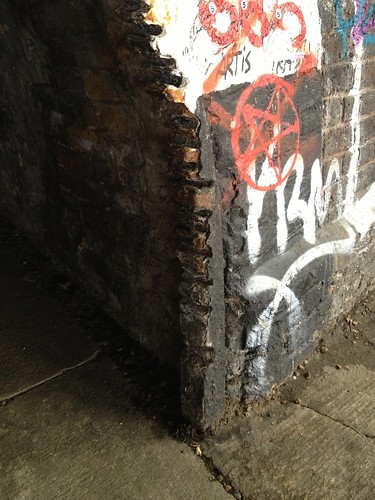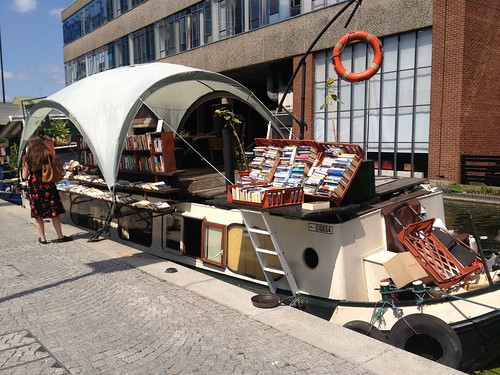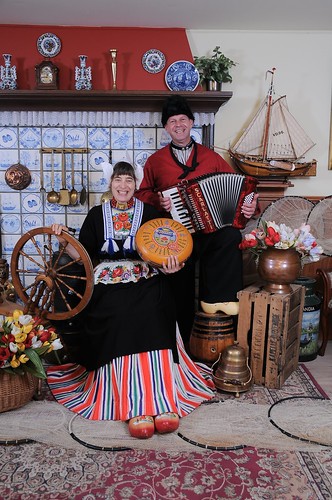It’s the height of summer in London and the weather is fine and I’m between jobs so I’ve got some time to put my feet up, sip a glass of
Pimm’s, and get a bit of back-blogging done. (That’s blogging about something that happened months ago because you don’t have the energy or motivation to go seek out something new.) Some of you may recall that I spent a few days in New York City right after I got back from Russia. (I’m really getting around these days, aren’t I? Vacation in New York City, wedding in Italy, oh, and did I mention I just spent a week in Amsterdam? Yeah, life is good.) But back to New York... it was a great vacation, made even better because it was my first ever trip to New York, and I got to share it with my good friends Karen and Steve, who astute Go Stay Work Play Live readers will remember from multiple posts, most recently about
Afternoon Tea.
 See? We were really there! That huge brick building in the background is the massive London Terrace apartment block which covers an entire city block in Chelsea and contains more than 1,700 individual apartments.
See? We were really there! That huge brick building in the background is the massive London Terrace apartment block which covers an entire city block in Chelsea and contains more than 1,700 individual apartments.
So yeah… New York City. It’s actually a bit weird that I hadn’t visited before. I flatter myself that I’m pretty well travelled by this point so to have missed one of the greatest cities on earth seems a bit of an oversight. No matter, I’ve been there now and it was definitely worth the wait. And it was great to be there with Karen and Steve, who’ve been before and so had a bit of local knowledge. They also had a lot more time to prepare than I did, considering I was coming straight off a big gig in a weird place. I managed to acquire a guidebook for New York and dig out the appropriate plug adapters from my now-impressive arsenal, but that’s about as much prep as I had.
No, wait, I did have one very important document, provided to me by a friend and colleague from Sochi gig, Anne. She lives in New York and sent me her personal guide to New York City, which turned out to be a highly useful document full of expert tips, mostly to do with what to eat and how to find it. Thus armed with Anne’s insider info and Karen and Steve’s exhaustive research, we proceeded to eat our way across the island of Manhattan. Here’s a little sample of the highlights:
1. Doughnut Plant
Thank you to Anne for this one. Her guide included a walk through the Flat Iron / Chelsea area, which included a recommendation to visit
Doughnut Plant on 23rd Street, between 7th and 8th Avenue at the famous
Chelsea Hotel. One of the original gourmet doughnut shops, Doughnut Plant is justifiably famous for its sophisticated flavour combinations, innovative square jelly-filled doughnuts, and use of fresh seasonal fruit and freshly roasted nuts in their glazes and toppings.
They also have fun decor, including this glazed doughnut bench.
And the trippiest bathroom I've seen in a while...
We sampled a few varieties: a cream-filled, glazed
tres leches cake donut, a stunning peanut butter and jelly and their signature crème brûlée doughnut with a perfect hard sugar topping and custard filling. Along with a good cup of coffee, it was special enough that I went back again a few days later with Anne. Don't judge me. You would have done the same thing given the chance.
Crème brûlée doughnut!
2. Soul Food
One of the things on Steve's To Do list for this trip was a walking tour of Harlem, followed by a soul food supper. The Harlem tour was interesting, sure, but I think we all agreed the highlight was supper at
Sylvia's Restaurant. Sylvia's is a Harlem institution, first opened in 1962, so while there were other options close by, we figured we might as well go straight to the source. It wasn't what I was expecting - I figured on a more diner/ greasy spoon vibe, but Sylvia's is a proper sit-down restaurant with super-friendly attentive table service.
Karen was keen to try the chicken and waffles combo, which has always struck me as an unlikely combination. I'm curious as to how it arose, and wonder why no one has ever suggested, say, Roast Beef & Pancakes or perhaps Fish 'n' French Toast.
I figured I didn't need to bother with the waffles since we'd already sampled this delightful offering from the good people at Lay's. They were weirdly tasty.
Steve and I opted for the traditional Southern fried chicken which came with a dizzying choice of side dishes including buttered corn, okra and tomato gumbo, black-eyed peas, candied yams and pickled beets. We both opted for collard greens and mac & cheese, and we were not disappointed. The fried chicken also comes with a "smothered" option, meaning the whole lot is covered in gravy. I was uncertain. Gravy is, of course, an inherently Good Thing, but the term "smothered" was potentially alarming, leading to visions of lovely crispy fried chicken losing all it's crunchy yumminess under a coating of stodge. I needn't have feared because our helpful server simply suggested I have the gravy
on the side, which was such a clear and brilliant thought that my problem was solved and her tip instantly rocketed into the lavishly generous zone.
Fried chicken, greens and mac & cheese. And beer, of course. The portions were generous, but it was America after all.
Fried chicken has never been a favourite food of mine; I'm not overly fond of anything that required you to separate meat from bone at the table, especially if it involves active gnawing. However, I'll happily make an exception the next time I'm in Harlem and visit Sylvia's again, I'll just need to make sure to fast for three days beforehand, or simply run there and back from Vermont.
3. Black and White cookies
Jerry Seinfeld: "Oh look Elaine, the black and white cookie. I love the black and white. Two races of flavor living side by side in harmony. It's a wonderful thing, isn't it?"
Elaine: "You know, I often wonder what you'll be like when you're senile."
Jerry: "I'm looking forward to it."
Elaine: "Yeah, I think it'll be a very smooth transition for you."
- Jerry and Elaine, in "The Dinner Party"
The famous black and white cookie, a nice little pitstop encountered at a random bakery during a random walk, on a day when we must have covered about 15 miles on foot. (No, really.) They're plain but classic - a simple, soft sugar cookie covered with half vanilla and half chocolate icing. Great for sharing, and for a nice photo op:
 Clearly Karen loves my blue toque
Clearly Karen loves my blue toque
4. Chopped Liver
I saved this for last because honestly, it was life-changing. Along with soul food the other thing on the To Do list was a meal at a real New York deli. Most visitors to New York will opt for
Katz's, the most famous deli in New York. Instead, we decided to try to find a more local, neighbourhoody place. Karen exercised her Googling skills and found
Second Avenue Deli, just a short walk from our hotel (though, paradoxically, not actually on Second Avenue).
It fit the bill exactly.
You could tell right away this was the kind of place that locals frequent. Across from us two young guys in yarmulkes were putting away an astonishing volume of food with a sort of grim determination that made their meal seem more like a chore than a pleasure. And a young family sat not far away introducing their little boy to the joys of matzo ball soup. Karen opted for a bowl of the same, along with a pickle juice martini. We also got a complimentary dish of dill pickles, half sour pickles and coleslaw, which made for a very promising start. (Pickles are something of an obsession for Karen, which led us, on an earlier night, to sample the deep-fried pickles at a local brew pub. Surprisingly not bad.)
Karen, happy with her soup, which was served with lovely slices of challah.
I've always been a fan of chopped liver, so I took the road less travelled and ordered potato latkes and a chopped liver sandwich. I would not be disappointed. My latke/chopped liver benchmark was set some decades ago at
The Main restaurant in Montreal, where the latkes are generally sublime but the chopped liver has always been a bit dry. Not so at Second Avenue Deli. (The Main, incidentally, always plays second fiddle to the much more popular Schwartz's just down the block, much like the Katz's-Second Avenue scenario...) My sandwich arrived and turned out to be a typically out-sized New York offering. I'd estimate there was at least 3/4 of a cup of chopped liver on EACH SIDE of that sandwich. And when I tasted it... Oh. My. God. I made a sort of "Are you kidding me?" face because it was unbelievably good. Smooth, creamy, moist and positively singing with the flavour of caramelised onions. It was transcendent. I was completely floored.

Soooooo good. And soooooo much. If we'd been staying in NY another day I would have taken some of this back to the hotel for later snacking. As it was, I just ate it all. It was much much too good to leave behind. Plus, apparently that's what you do in New York. You eat until you're begging for mercy, and then you have a hot dog.
As evidence of the heavenly nature of Second Avenue Deli's chopped liver, I offer this anecdote:
Steve is a great guy to travel with because he's got that naturally gregarious sort of nature that means he can strike up a friendly conversation with just about anyone, and frequently does. So after the determined young men across the aisle finally departed and were replaced by two women - obviously tourists - Steve ended up chatting with them as they contemplated the menu. Still in the throes of ecstasy over my chopped liver sandwich, and gamely making my way through the second half, I quickly suggested to one woman that she must try it. "Seriously, it is life-changing." I said. She demurred... She liked chopped liver, but her friend was not a fan, so she was wavering. Quickly the waiter offered her a small taste on a plate and her face when she sampled it was exactly the same "Are you kidding me?" face I'd made just minutes earlier. "See what I mean?" I said. And she ordered the chopped liver. I rest my case.
So yeah, New York was great. And I didn't even tell you about
Papaya Dogs (No papayas are harmed in the making of Papaya King Hotdogs), or the oyster po' boy at Chelsea Market, or the crazy good concrete from
Shake Shack (A concrete is frozen custard mixed with awesomeness, in this case a heady combination of chocolate frozen custard, peanut butter sauce, chocolate covered pretzels and marshmallow sauce. Better still, Shake Shack now has a branch open at Covent Garden! Yay!). Of course we also did all the mandatory tourist stuff: we saw a Broadway show, went up the Empire State Building, walked the Brooklyn Bridge and explored newly trendy DUMBO, strolled the Guggenheim, visited Tiffany’s, saw Wall Street, sailed to the Statue of Liberty, and visited Central Park. Maybe I'll even blog about that some day. For now, you can check out some photos at the
NYC Flickr album, and start to plan the menu for your next visit to New York. Just remember to save room for the chopped liver.
 Mandatory New York-y photo of Pam.
Mandatory New York-y photo of Pam.









































